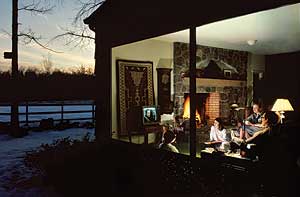Architects' Widening View of Windows: Technical Advances Elevate the Role of Fenestration
The Hermetically Sealed Building
It's hard to talk in generalities, yet trends can be identified in mid to late 20th century growth: suburbanization, increased density, conformity and standardization of design for middle-class home, glassy and tightly sealed boxes for offices and business. The picture window and the great sheets of plate glass in residential, commercial, and public buildings provided fabulous views and daylight but closed up the buildings to natural ventilation.
|
PICTURE THIS: Windows
on the American Home Picture This: Windows on the American Home explores 200 years of the cultural, aesthetic, and technical accomplishments of windows at the National Building Museum in Washington, D.C. (through August 11th). This exceptionally informative, yet accessible, exhibition was conceived and sponsored by Andersen Corporation in celebration of its 100th anniversary. Picture This explores several themes, each of which elucidates the defining role windows have played in the design and culture of the American home. History meets theory, and invention meets critique, in a robust multimedia presentation - including film and video clips, models, photographs, advertisements, historic artifacts, and a lucid and graphic timeline. The exhibition examines the extent to which technological invention has determined architectural form - before the Industrial Revolution made the dependence transparent - has not often been analyzed outside of academia without being arcane. For more information contact The National Building Museum www.nbm.org or The Minnesota History Centerwww.mnhs.org. |
Advances in heating, air conditioning and ventilation systems followed, ironically leading to the loss of design skill in the use of windows for daylight and ventilation. The technological advances produced a "higher standard of living," but in the process the building occupant's relationship with the natural environment was cut off. The building became a machine for living, but the interior and exterior spaces were isolated one from the other. Again, we're talking cultural attitudes here, in the 1950s and 1960s, when energy sources were plentiful and cheap. Environmental issues revolving around the orientation, size, and shape of windows in a building in relationship to its site and climate sunk deep in many architect's consciousness. The environmental behavior of windows was recognized and studied, but not as an urgent priority.
Then came the energy crises of the 1970s when prices skyrocketed.
The net cost of a window unit was, in effect, increased because its performance in many designs added to the operating expense of the building. Architects and engineers responded and energy-conscious design gained momentum.










